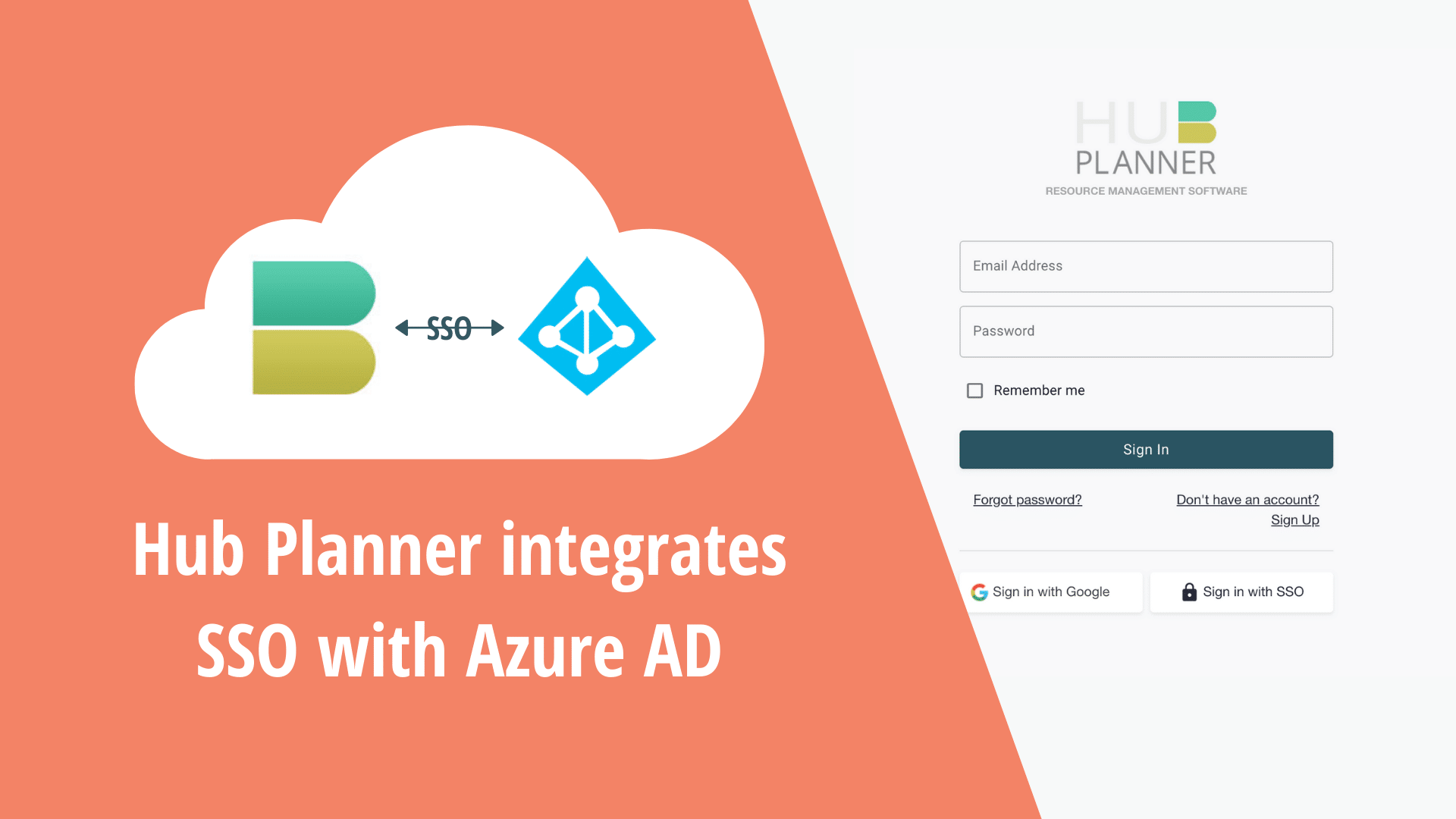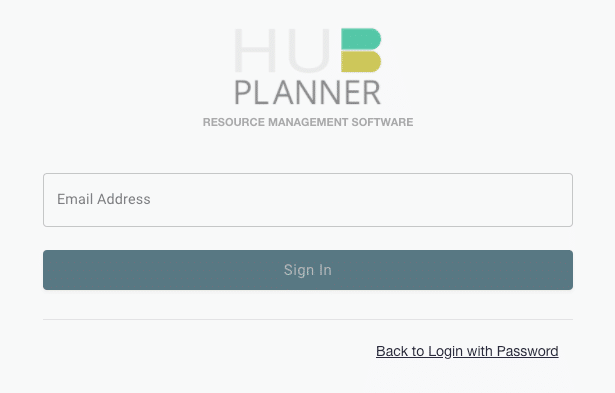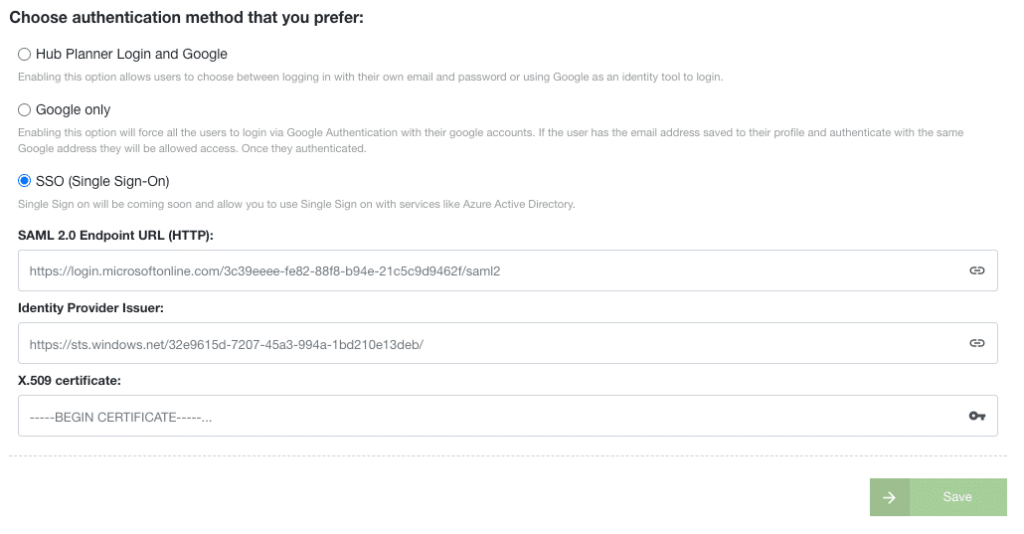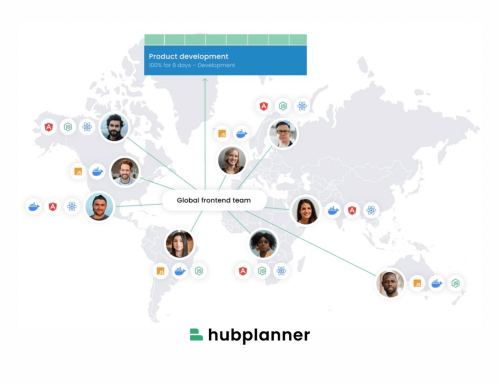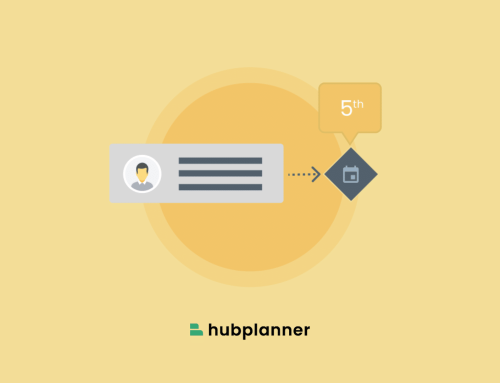Hub Planner adds Single Sign On SSO via Azure AD
Single Sign-On (SSO) authentication gives users secure access to Hub Planner with help from your identity management system. Hub Planner have integrated with Azure AD SAML based system.
Authentication method that allows users to log into multiple applications using one set of credentials.
Why use SSO?
For me, there are 3 focused benefits to adopting a single sign on process for companies. Theres no particular order of preference. It just depends whether you’re looking at it from a users position or a higher level view. From a company owners point of view, security is the most valuable benefit. From a resources point of view, convenience and quickness is key.
Quick & Easy:
How many applications do you log into on a daily basis? Remove the time-consuming efforts of entering credentials for each software by adopting single sign on. It’s quicker and easier. In turn, it boosts productivity. SSO, eliminates the need to sign into and out of multiple applications providing a seamless and secure integrated experience for Hub Planner users.
Convenience:
Companies use numerous applications throughout the working day. With SSO, you require one set of login credentials. This means that users don’t have to remember multiple passwords/logins for each and every application they use. For example, using SSO Azure AD with Hub Planner: When a resource opens Hub Planner, they will bypass the login screen direct to their preferred starting page.
No need to remember multiple complex passwords, just one.
Security:
The main benefit of single sign on, is that users can authenticate and personalise easily without having to transmit any actual personal data over the internet. Users will only have to authenticate once per session. Unless they switch browsers, clear cookies or use another device. SSO also prevents users using easy-to-guess or repeating the same password for all logins which would not be good for a cyber attack. Less passwords scribbled post-it notes and more secure access to Hub Planner and your suite of softwares. By having the one set of credentials means that there are less chances of a cyber attack. Think of how many applications and software do you currently log into? Thats how many chances a cyber criminal has to attack your data. Adopting SSO, eliminates the majority of requirements for credentials. Therefore, less opportunities for a cyber attack.
How does SSO work in Hub Planner?
Account Owners will integrate Hub Planner with Azure AD. Linking the two softwares will enable SSO for all resources. Once SSO is set and enabled, resources will be able to seamlessly access Hub Planner using SSO. Upon logging in, the IMS will have validated the identity of the resource. Resources are validated without the requirement of entering credentials.
Login using Single Sign On
Resources will sign into their company’s identity management system (IDS). For example, Azure AD. By doing so, Azure AD allows resources and teams to gain access to all company accounts and softwares. Note, this is the only time that resources will require to enter credentials. When logging into Hub Planner, resources simply click the ‘Sign in with SSO’ button. In the background, and in a flash: Hub Planner will check that you are successfully signed into Azure AD. In turn, the Azure AD will confirm with Hub Planner that you are indeed the legitimate resource. Once verified, you will be signed into Hub Planner. From the get go, once resources have successfully logged into their SSO provider, resources are continuously identified as verified. In essence, resources can continue to successfully use Hub Planner and of course other applications that you use without having to re enter credentials.
Note, Hub Planner never saw or processed the users credentials.
Each user who access Hub Planner for the first time after SSO has been enabled, will be required to enter credentials. Once completed, this will never be required again. In the authentication process – Hub Planner will match user email address used to validate SSO with the email address used for signing into Hub Planner.
Simple Steps to Single Sign On
- Resource logs into their SSO provider Identity Management System IDS (Azure AD) successfully.
- Azure AD verifies Resource credentials.
- Next, the Resource will open Hub Planner.
- Hub Planner verifies resource has successfully signed into and has been verified by Azure AD.
- Azure AD will confirm identity of the Resource to Hub Planner.
- The Resource is successfully logged into Hub Planner.
- Resources accesses Hub Planner.
Identity Management System Providers of SSO
Typically, there are multiple SSO providers or Identity Management Systems. Each will differ by brand, vendor and features, etc. However they all provide the same principal feature. All provide SSO capability by integrating with supported applications. Hub Planner have integrated with the Azure AD as the Sing Sign On provider.
Who are Azure AD
Azure Active Directory Seamless Single Sign-On (Azure AD Seamless SSO) automatically signs users in when they are on their corporate devices connected to your corporate network – Microsoft
The powerhouse of Microsoft produced Azure AD. Azure AD is an identity and access management platform that links to your current user directory system. Instead of going straight to Hub Planner to log in. The user will navigate to: Azure AD. Enter credentials. The AD will read the credentials to identify the user. Once the AD has authenticated the identify of the user. The user will be routed to Hub Planner, where the credentials will be bypassed. To add Hub Planner to your Azure AD, click here.
Conclusion:
In essence, SSO means, I don’t have to enter my credentials again to access another application. For example, if I log into my web portal or application. If i want to access Hub Planner, I don’t need to login again. It’s more secure, it’s quicker, all round it’s less hassle. Having SSO interacting with applications like Hub Planner automatically verifying your identity is seamless. It’s like a ‘sign in assistant’ taking away the burden of entering credentials to access systems used throughout the day.

